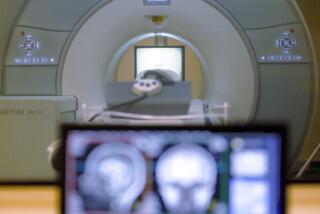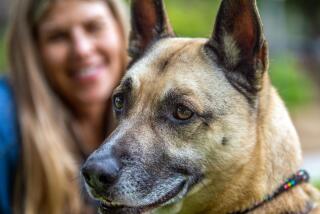Laser Surgery May End Bad Times for Good Dog
- Share via
For Buffer, it truly has been a dog’s life lately.
The 10-year-old Labrador retriever has been suffering seizures for the last four months because an ever-growing--but benign--tumor is pressing on nerves in his brain.
But this morning, Buffer--the faithful companion of a San Diego quadriplegic--will undergo laser brain surgery, the most ambitious veterinary procedure attempted to date at UC Irvine’s Beckman Laser Institute and Medical Clinic.
A UC Davis neurosurgeon, Dr. James Boggan, is flying down to the Irvine campus to perform the procedure. Boggan, who is donating his services, has done the procedure on a dog and cat at Davis, assisted by veterinarians from the veterinary school there.
Buffer’s owner, Anthony Pizzo, 42, said he realizes that his dog has been put through a lot, but that Buffer is “a real faithful pet” and deserves a better life. Buffer, he said, has traveled across the country with him and has lived up to the reputation of man’s best friend since a 1979 trucking accident left Pizzo, a former wood shop teacher and truck driver, paralyzed and confined to a wheelchair.
“He was part of our family,” said Pizzo, who now lives with his parents, “until these seizures started to slow him down.”
The seizures are being caused by a meningioma tumor, now about the size of a walnut, pressing against nerves in Buffer’s brain, said Debra Cohen, a licensed animal health technician at the Newport Beach Veterinary Hospital, where Buffer spent Thursday night and where he will be prepped with IV lines before this morning’s operation.
When the seizures were first noticed in late March, Pizzo took Buffer to a San Diego veterinarian, who tried to treat him with anti-convulsives for several days, Cohen said. When that did not work, Buffer was referred to Newport Beach veterinarian Jeffrey Cohen (Debra’s husband), a specialist in internal medicine, who suspected the dog had a brain tumor.
CAT Scan Confirms Diagnosis
That diagnosis was confirmed when Buffer underwent a CAT (computerized axial tomography) scan, a sophisticated X-ray, at the Huntington Research Institute in Pasadena, a medical institute noted for its work on brain tumors that also performs some work on animals for research purposes, Debra Cohen said.
The institute also determined that the tumor was not malignant, she said. However, it was learned that the tumor is fast-growing and in an area full of blood vessels--meaning that conventional surgery could not be performed because the animal would most likely bleed to death.
But laser surgery, she said, reduces that risk because the high-intensity beam of light automatically cauterizes the vessels as it slices through tissue.
Marie Wilson, supervisor of the veterinary treatment program at the Beckman Laser Institute, said the facility is one of few in California that make laser technology available to veterinary medicine. Until now, one of the most sophisticated procedures performed on animals at the facility has been hematoporphyrin dye treatment, involving the injection of a dye that collects in cancerous tissues. A laser is then shone on the dye, activating it and destroying the cancerous tissue. Lasers have also been used to remove other tumors on animals, Wilson said. Laser-trained physicians have performed the procedures, working in conjunction with veterinarians, she said.
‘Soft Place in Our Hearts’
Today’s procedure will involve the use of a CO2 laser, directed through a microscope, she said. Boggan will be assisted by Hermosa Beach veterinary surgeon Curt Willauer. The procedure will be videotaped so that other veterinarians and doctors will be able to learn from it, she said.
Boggan is giving his time, and the laser institute is paying his expenses, Wilson said, “because, I don’t know, we have a soft place in our hearts for animals.”
Pizzo, a real estate agent, said he will probably pay about $500 in expenses for today’s operation in addition to the $2,000 he estimates that he has already spent on Buffer’s treatment.
“But you can’t put a price on a pet’s companionship and love,” he said.
Buffer--so named because of his shiny coat and Pizzo’s job as a wood shop teacher when he got the pup--has maintained his good nature through the months of treatment, but he’s not the same dog, Pizzo said. He has been on steroids to keep the inflammation down, but the medication has caused the pooch to put on weight and have bladder problems, he said. Buffer once had the run of the house and is unhappy to be kept outside all the time now, he said. And Buffer is less alert and isn’t as agile as he used to be.
‘If He Makes It, Great’
“He’s slowed down. He doesn’t run or jump anymore,” Pizzo said. “In the morning, he would run in and jump in my lap and lick my face, and now he doesn’t do that.”
Without the operation, the tumor will keep growing and eventually kill Buffer, Debra Cohen said. Buffer’s chances for surviving the procedure have been put at better than 50%, she said.
Pizzo said he knows the operation is a risk.
“If he makes it through the operation, great, but if I lose him, I’ll know I gave it a try,” Pizzo said. “His quality of life is not real good now, and I want to make it better for him, or have him pass on to another life.”
More to Read
Sign up for Essential California
The most important California stories and recommendations in your inbox every morning.
You may occasionally receive promotional content from the Los Angeles Times.










